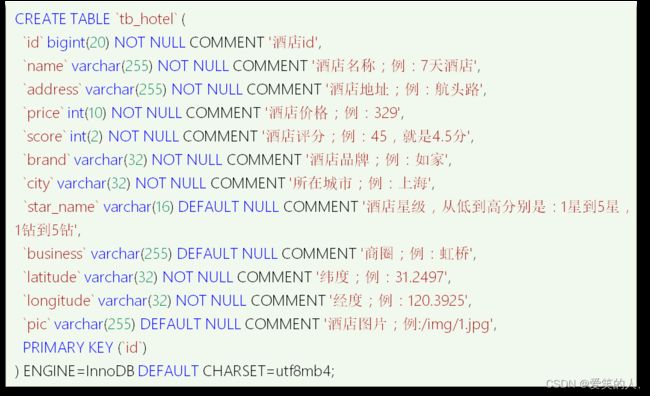RestClient操作索引库
RestClient是es官方提供的一套用于通过代码操作es的api,es官方提供了不同语言的客户端,这些客户端本质上就是组装的DSL语句,通过http请求发送给es
步骤一:数据库中导入表和数据
步骤二:分析数据结构
在kibana中设置
步骤三:初始化JavaRestClient
使用es需要引入对应的依赖,注意依赖版本要和es版本一致
org.elasticsearch.client elasticsearch-rest-high-level-client
因为SpringBoot默认的ES版本是7.6.2,所以我们需要覆盖默认的ES版本:
1.8
7.12.1
创建一个测试类,先初始化RestHighLevelClient,连接到es,代码如下
import java.io.IOException;
public class HotelIndexTest {
private RestHighLevelClient client;
//声明对象,并做对象初始化连接到es,提高代码复用性
@BeforeEach
void setUp(){
this.client = new RestHighLevelClient(RestClient.builder(
HttpHost.create("http://192.168.61.130:9200")
));
}
@AfterEach
void tearDown() throws IOException {
this.client.close();
}
}
步骤4:创建索引库
成功后创建一个新的索引库,这里的DSL语句需要我们手动编写或者自己引入,我先新建一个类,写好DSL语句,在Dev Tools写一个,然后复制到代码里去,如下
public class HotelConstants {
public static final String MAPPING_TEMPLATE = "{\n" +
" \"mappings\": {\n" +
" \"properties\": {\n" +
" \"id\": {\n" +
" \"type\": \"keyword\"\n" +
" },\n" +
" \"name\":{\n" +
" \"type\": \"text\",\n" +
" \"analyzer\": \"ik_max_word\",\n" +
" \"copy_to\": \"{all}\"\n" +
" },\n" +
" \"address\": {\n" +
" \"type\": \"keyword\",\n" +
" \"index\": false\n" +
" },\n" +
" \"price\": {\n" +
" \"type\": \"integer\"\n" +
" },\n" +
" \"score\": {\n" +
" \"type\": \"integer\"\n" +
" },\n" +
" \"brand\": {\n" +
" \"type\": \"keyword\",\n" +
" \"copy_to\": \"{all}\"\n" +
" },\n" +
" \"city\": {\n" +
" \"type\": \"keyword\"\n" +
" },\n" +
" \"starName\": {\n" +
" \"type\": \"keyword\"\n" +
" },\n" +
" \"business\": {\n" +
" \"type\": \"keyword\",\n" +
" \"copy_to\": \"{all}\"\n" +
" },\n" +
" \"location\": {\n" +
" \"type\": \"geo_point\"\n" +
" },\n" +
" \"pic\": {\n" +
" \"type\": \"keyword\",\n" +
" \"index\": false\n" +
" },\n" +
" \"all\":{\n" +
" \"type\": \"text\",\n" +
" \"analyzer\": \"ik_max_word\"\n" +
" }\n" +
" }\n" +
" }\n" +
"}";
}然后写新增索引库的方法,并将刚才的DSL语句引入到下面代码中,如下
@Test
void createHotelIndex() throws IOException {
//1,创建Request对象
CreateIndexRequest request = new CreateIndexRequest("hotel");
//2,准备请求的参数:DSL语句
request.source(MAPPING_TEMPLATE, XContentType.JSON);
//3,发送请求
client.indices().create(request, RequestOptions.DEFAULT);
}
步骤五:删除索引库、判断索引库是否存在
//删除索引库
@Test
void testDeleteHotelIndex() throws IOException {
//创建删除对象
DeleteIndexRequest request = new DeleteIndexRequest("hotel");
//删除请求
client.indices().delete(request,RequestOptions.DEFAULT);
} //判断索引是否存在
@Test
void testExistsHotelIndex() throws IOException {
//查看索引库
GetIndexRequest getIndexRequest = new GetIndexRequest("hotel");
//判断索引库是否存在
boolean exists = client.indices().exists(getIndexRequest, RequestOptions.DEFAULT);
System.out.println(exists ? "索引库存在":"索引库不存在" );//打印true或者false判断索引库是否存在
}
文档的基本操作
新增文档:通常情况新增的数据都是从数据库导入的,所以需要先连接数据库并查到数据,并且根据数据库的字段创建对应的索引库,然后才是导入数据,先创建pojo对象,这里取名Hotel,
@Data
@TableName("tb_hotel")
public class Hotel {
@TableId(type = IdType.INPUT)
private Long id;
private String name;
private String address;
private Integer price;
private Integer score;
private String brand;
private String city;
private String starName;
private String business;
private String longitude; //经度
private String latitude; //纬度
private String pic;
}这个数据库表有一个地理位置,用经纬度表示,是两个字段,而在es中经纬度是将这两个字段拼接起来的一个字段,格式不同所以要做转换,所以要再写一个pojo对象这里叫做HotelDoc
@Data
@NoArgsConstructor
public class HotelDoc {
private Long id;
private String name;
private String address;
private Integer price;
private Integer score;
private String brand;
private String city;
private String starName;
private String business;
private String location;
private String pic;
public HotelDoc(Hotel hotel) {
this.id = hotel.getId();
this.name = hotel.getName();
this.address = hotel.getAddress();
this.price = hotel.getPrice();
this.score = hotel.getScore();
this.brand = hotel.getBrand();
this.city = hotel.getCity();
this.starName = hotel.getStarName();
this.business = hotel.getBusiness();
this.location = hotel.getLatitude() + ", " + hotel.getLongitude();//这里将数据库的两个字段拼为一个
this.pic = hotel.getPic();
}
}新建一个测试类,通过mybatisplus查询数据库内的内容上传到es中
@SpringBootTest
public class HotelDocumentTest {
@Autowired
private IHotelService hotelService;
private RestHighLevelClient client;
@Test
void testAddDocument() throws IOException {
//根据id查询数据
Hotel hotel = hotelService.getById(61083L);
//因为没有经纬度,设置了一个新实体类混合经纬度
HotelDoc hotelDoc = new HotelDoc(hotel);
//1.准备Request对象
IndexRequest request = new IndexRequest("hotel").id(hotelDoc.getId().toString());
//2.准备Json文档
request.source(JSON.toJSON(hotelDoc),XContentType.JSON);
//3.发送请求
client.index(request,RequestOptions.DEFAULT);
}
//声明对象,并做对象初始化连接到es,提高代码复用性
@BeforeEach
void setUp(){
this.client = new RestHighLevelClient(RestClient.builder(
HttpHost.create("http://192.168.61.130:9200")
));
}
@AfterEach
void tearDown() throws IOException {
this.client.close();
}
}
查询操作
@Test
void testGetDocumentById() throws IOException {
//准备request
GetRequest request = new GetRequest("hotel", "61083");
//发送请求得到响应
GetResponse response = client.get(request, RequestOptions.DEFAULT);
//解析响应结果
String json = response.getSourceAsString();
//反序列化json
HotelDoc hotelDoc = JSON.parseObject(json, HotelDoc.class);
System.err.println(hotelDoc);
}删除操作
@Test
void deleteDocumentest() throws IOException {
//1、准备request
DeleteRequest request= new DeleteRequest("hotel", "61083");
//2、发送请求
client.delete(request,RequestOptions.DEFAULT);
}
修改操作
方式一:全量更新。再次写入id一样的文档,就会删除旧文档,添加新文档
方式二:局部更新。只更新部分字段,我们演示方式二
@Test
void testUpdateDocumentById() throws IOException {
//1,新建request对象
UpdateRequest request = new UpdateRequest("hotel", "61083");
//2.准备参数
request.doc(
"price","1000",
"starName","四钻"
);
//3,发送请求
client.update(request,RequestOptions.DEFAULT);
}批量数据导入操作
void BulkRequest() throws IOException {
//1、创建request
BulkRequest bulkRequest = new BulkRequest();
//批量查询数据库数据
List list = hotelService.list();
//遍历是因为数据库数据较多
for (Hotel hotel : list) {
//转换为文档类型
HotelDoc hotelDoc = new HotelDoc(hotel);
//2、准备参数,添加多个新增的Request
bulkRequest.add(new IndexRequest("hotel").
id(hotelDoc.getId().toString()).
source(JSON.toJSONString(hotelDoc),XContentType.JSON));
}//这里就是一个链式编程,直接调用了对象的方法,而不像之前是分步写
//不理解遍历的,也可以 自己一条条数据的添加进去,如下,就是很麻烦
/*bulkRequest.add(new IndexRequest("hotel").
id("1").
source(JSON.toJSONString(hotelDoc),XContentType.JSON));
bulkRequest.add(new IndexRequest("hotel").
id("2").
source(JSON.toJSONString(hotelDoc),XContentType.JSON));
bulkRequest.add(new IndexRequest("hotel").
id("3").
source(JSON.toJSONString(hotelDoc),XContentType.JSON));*/
//3、发送请求
client.bulk(bulkRequest,RequestOptions.DEFAULT);
}



